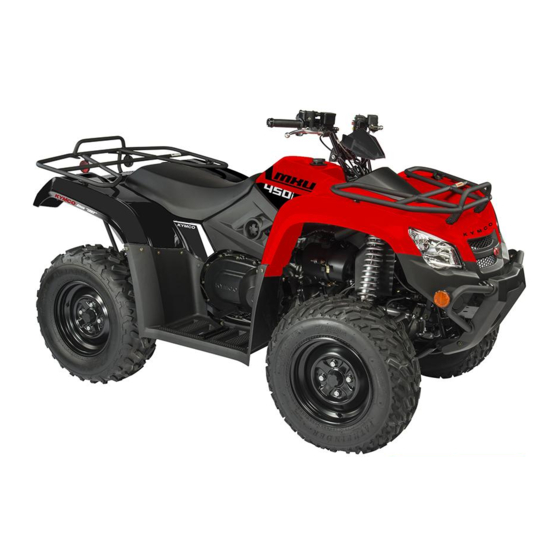Table of Contents
Advertisement
Advertisement
Table of Contents

Subscribe to Our Youtube Channel
Summary of Contents for KYMCO MXU 450i
- Page 9 MAXIMUM TONGUE WEIGHT: 35 lbs. (16 kg) MAXIMUM TOWING CAPACITY: 1050 lbs. (477 kg) EPA label 0 5 / 2 0 11 SVIA label Front of ATV frame...
- Page 10 Headlights Power Distribution Modulel Shift Lever Storage Compartment Taillight/brakelight Aluminum Wheel Battery Starter Switch Foot (rear) Brake Pedal Headlight Hi/lo Switch Coolant Reservoir Engine Stop Switch Hand Brake Lever Reverse Override Button Throttle Limiter Ignition Switch Electrical Access Panel 2wd/4wd Selector Switch Seat Latch Throttle Lever...
-
Page 31: Active Riding
ACTIVE RIDING 4. Always try to park your ATV on level ground. If you have to park on a hill, shift the ATV’s transmission into low gear. Always shift the transmission into LOW range when 5. Engage the parking brake (brake lever lock) operating on wet or uneven terrain, when towing or pushing heavy loads, or when using a plow. - Page 32 ACTIVE RIDING STARTING Once the engine is warm, your ATV is ready to ride. 1. Keep both of your feet on the footrests and both hands on the handlebars at all times 2. Hold the brake lever, and release the parking brake (lever lock) 3.
-
Page 33: Wide Turns
ACTIVE RIDING WIDE TURNS SHARP TURNS About 20% of ATV accidents happen during turns. If you don't After mastering wide turns, practice the advanced skill of sharp understand turning techniques, you can lose control of your ATV turns. Use this riding method for sharp turns: by losing traction, plowing, or tipping. -
Page 34: Quick Turns
ACTIVE RIDING QUICK TURNS Quick turns are the most difficult turns, and should only be attempted after you have become very familiar with the han- dling characteristics of your ATV. Use this riding method for quick turns: 1. Ease off the throttle as you approach the turn to slow down 2. - Page 35 ACTIVE RIDING K-TURNS Use the K-turn maneuver if you accidentally stall your ATV while riding uphill. Using a K-turn will enable you to point the ATV downhill in a controlled manner and prevent the ATV from roll- ing back. Use the turning method on this page for K-turns: 1.
-
Page 36: Riding Uphill
ACTIVE RIDING RIDING UPHILL Approximately 20% of ATV accidents that happen while riding on hills and as a result of the ATV rolling or flipping. Use ex- treme caution when riding your ATV on hills, and use this method for riding uphill. 1. -
Page 37: Riding Downhill
ACTIVE RIDING RIDING DOWNHILL Success in riding downhill depends on how familiar and skilled If you're in a situation where you absolutely have to sidehill on you are with using your ATV's brakes. Use care to balance your ATV, use this riding method: braking force and downhill speed so you don't lose control and flip your ATV over. - Page 38 ACTIVE RIDING SWERVING Swerving is an emergency maneuver required to avoid an ob- stacle, but is similar in action to a quick turn. Swerving differs as a quick turn involves slight acceleration during the turn. Do not accelerate if you swerve to maintain better control of your ATV.
-
Page 39: Crossing Obstacles
ACTIVE RIDING CROSSING OBSTACLES Crossing obstacles is dangerous, and even experienced ATV riders should avoid this practice if possible. Riding over logs, rocks, and ruts means you must combine all the active riding skills into one big motion. Your ATV will respond differently for different obstacles (logs, ruts, etc.), but these are general guide- lines for overcoming two-track (both tires contacting the ob- stacle at the same time) obstacles:... -
Page 40: Skidding Or Sliding
ACTIVE RIDING TIPS PARKING ON A HILL In the rare case you need to park your ATV on a hill: Riding an ATV and driving a automobile have some similarities; however, there are certain situations that require special attention: 1. Keep the ATV’s transmission in gear * Reversing * Skidding or Sliding 2.

















Need help?
Do you have a question about the MXU 450i and is the answer not in the manual?
Questions and answers